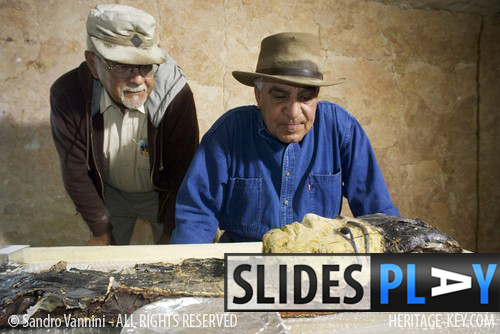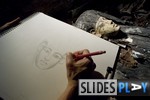 When KV63 was discovered in 2006, it represented the first tomb to be discovered in the Valley of the Kings in 80 years, since the famous explorer Howard Carter uncovered the treasures of the Tomb of King Tutankhamun. It restored hope that there is still more mystery to uncovered in the region which was said to contain no more secrets, and even today the hunt continues to find what is hidden in the next tomb – KV64. Sandro Vannini, the venerable Egyptology photographer, took many photographs from the latest excavations, including one of the most interesting finds – seven wooden sarcophagi.
When KV63 was discovered in 2006, it represented the first tomb to be discovered in the Valley of the Kings in 80 years, since the famous explorer Howard Carter uncovered the treasures of the Tomb of King Tutankhamun. It restored hope that there is still more mystery to uncovered in the region which was said to contain no more secrets, and even today the hunt continues to find what is hidden in the next tomb – KV64. Sandro Vannini, the venerable Egyptology photographer, took many photographs from the latest excavations, including one of the most interesting finds – seven wooden sarcophagi.
Although the 18th Dynasty tomb was not used for burial, it was officially declared to be a tomb by the Director of Egypt’s Supreme Council of Antiquities, Dr Zahi Hawass, who believes it to have been the intended burial place of Queen Kiya – the mother of King Tutankhamun. The presence of many large storage jars and empty sarcophagi suggests that the tomb was used for the embalming stage of the mummification process.
Heritage Key is working with Sandro to bring his photography online for you to enjoy, and be able to see the excavations from the comfort of your own chair, including more photography from inside KV63 by Sandro Vannini. You can also find out the latest news from the excavations in the Valley of the Kings through our exclusive Heritage Key videos, as well as digitally visiting Ancient Egypt from your own computer, through our online, virtual experience – King Tut Virtual exhibition at Heritage Key VX.
Don’t miss out on new treasures!
This post is part of a series focussing on amazing photographs from ancient Egypt. Keep checking back as well keep adding new images by Sandro Vannini. To make sure you don’t miss out on any of the updates, simply subscribe by email to receive notifications when new images are uploaded. For the more digitally advanced, there’s also an RSS feed with updates available.
Suggest a Featured Artefact
We’re taking suggestions! which of King Tut’s treasures you would love to see highlighted on Heritage Key, and we’ll consult Sandro’s extensive archives to see what we can find for you!
Ask Sandro
We’ll be sitting down with our favourite photographer for an extended chat soon, so if you have any questions for Sandro we’ll send the answers straight to you!
Sandro Vannini’s Photography
Sandro took several hundreds of photographs whilst at the KV63 site with his Kodak DCS Pro SLR/n camera, capturing archaeologists as they surveyed the tomb and the artefacts they had uncovered. Decades of professional photography experience have honed Sandro’s skills and his photography demonstrates this perfectly – capturing the details of the tomb, and the people behind the work that has gone into excavating it. From the finds inside the tomb, some of the most remarkable are the seven coffins which were found.
The Seven Sarcophagi
Seven wooden sarcophagi found inside Tomb KV63 included one which was sized for a child, and another which had been made to fit an infant. The identity of whom would have occupied these coffins is unknown, but it’s entirely possible that they were created for a family. There is also the possibility that the tomb was used as an embalmer’s room, and the coffins were a stockpile.
Two of the adult coffins and the child-sized coffin were all adorned with a yellow painted mask, which has been hypothesised to signify that the intended occupants would have been female. Glass was also used for the eyes on one of the coffins, which is a material usually reserved only for royalty.
Some of the coffins that were discovered are in a damaged state, as is clearly visible in Sandro’s photographs. All but two of the coffins have suffered from termite damage, which had resulted in a black paste. The termites are thought to have originated from the worker huts above the tomb, and therefore are from the age of Ancient Egypt.
Also found was a smaller wooden coffin, covered in a pink-tinged gold, which is likely to be a funerary figurine. It is completely unmarked, and contained nothing, so identification of whom this coffin belonged to would be difficult.
 Called upon to draw the new finds discovered in KV63, Susan Osgood (an artist for the University of Chicago’s Epigraphic Survey) created a sketch of one of the painted sarcophagus, the in-progress of which is shown in one of Sandro’s photographs. Susan Osgood’s archaeological drawings, including those she undertook in Tomb KV63, will be exhibited at the Egyptian Museum of the University of Bonn from the 26th November, continuing until June 2010, after which it will move to the Museum August Kestner in Hanover, showing from July 15th, 2010 until October 2010. More details about the exhibtion can be viewed at Susan Osgood’s website, or at the official dig site of KV63.
Called upon to draw the new finds discovered in KV63, Susan Osgood (an artist for the University of Chicago’s Epigraphic Survey) created a sketch of one of the painted sarcophagus, the in-progress of which is shown in one of Sandro’s photographs. Susan Osgood’s archaeological drawings, including those she undertook in Tomb KV63, will be exhibited at the Egyptian Museum of the University of Bonn from the 26th November, continuing until June 2010, after which it will move to the Museum August Kestner in Hanover, showing from July 15th, 2010 until October 2010. More details about the exhibtion can be viewed at Susan Osgood’s website, or at the official dig site of KV63.
One theory suggested revolves around the reign of Tutankhamun’s father, Akhenaten. Whilst in power, Akhenaten dismissed the worship of the old gods in favour of his own deity, Aten. As the residents of Ancient Egypt had been worshipping and relying upon the old gods for many centuries, for a new Pharaoh to come and change such a tradition would likely have caused much uproar.
After Akhenaten’s reign, King Tutankhamun took the throne, and he reinstated the worship of the old gods. It is believed that again there would have been divisions over such a move, with one side possibly finding themselves as the endangered minority. A theory is that KV63 may have been used as a hiding place for the coffins and jars that were found there.
MOVIE: Dr Zahi Hawass in the Valley of the Kings: KV64 is going to be discovered!
In a previously unexplored section of the area, Dr Zahi Hawass’ team uncovered a possible tomb entrance in the Valley of the Kings which saw the discovery of a stairway, which Dr Hawass is hoping will be the discovery of KV64. The possibility of this new discovery, of which the mystery has yet to be revealed, is being excavated by an all-Egyptian team for the first time. It’s not even sure on who may be inside, if this is a tomb either, with Ramesses, Thutmose and Neferiti all being suggested as the possible occupant.
You can see the transcript of the movie over on our video page, as well as seeing other fascinating films from the Valley of the Kings shot by Sandro in our weekly series. Additionally, you can find out more about Ancient Egypt here at Heritage Key, and if you want to do some discovery of your own, you can explore KV62 – King Tutankhamun’s tomb – in 3D in our exciting virtual experience! Also be sure to keep up to date on all new postings about Sandro’s photography from Egypt by subscribing to our feed, simply by entering your email address above.